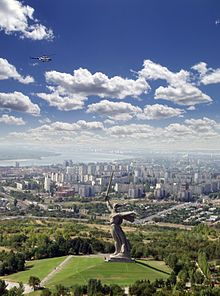The Motherland Calls
This article includes a list of general references, but it lacks sufficient corresponding inline citations. (November 2015) |
| The Motherland Calls | |
|---|---|
| Soviet Union / Commonwealth of Independent States | |
 Mamayev Kurgan with the statue | |
| For heroes of the Battle of Stalingrad | |
| Unveiled | 15 October 1967 |
| Location | 48°44′32.5″N 44°32′13″E / 48.742361°N 44.53694°E near |
| Designed by | Yevgeny Vuchetich, Nikolai Nikitin |
The Motherland Calls (Russian: Родина-мать зовёт!, romanized: Rodina-mat' zovyot!, literally Homeland-Mother Is Calling) is a statue in Mamayev Kurgan in Volgograd, Russia, commemorating the Battle of Stalingrad. It was designed by sculptor Yevgeny Vuchetich and structural engineer Nikolai Nikitin, and declared the largest statue in the world in 1967. Today, it is the tallest statue of a woman in the world, not including pedestals.
The Motherland Calls is highly complex from an engineering point of view, due to its characteristic posture with a sword raised high in the right hand and the left hand extended in a calling gesture. The technology behind the hollow statue is based on a combination of prestressed concrete with wire ropes structure, a solution which can be found also in another work of Nikitin's, the super-tall Ostankino Tower in Moscow.
The monument was inspired by the Ancient Greek sculpture the Winged Victory of Samothrace, and was modelled on a local woman, Valentina Izotova.[1]
Construction and dedication
When the memorial was dedicated in 1967 it was the tallest sculpture in the world, measuring 85 metres (279 ft) from the tip of its sword to the top of the plinth. The figure itself measures 52 metres (171 ft), and the sword 33 metres (108 ft). Two hundred steps, symbolizing the 200 days of the Battle of Stalingrad, lead from the bottom of the hill to the monument. The lead sculptor was Yevgeny Vuchetich, and Nikolai Nikitin handled the significant structural engineering challenges of the 7,900 tonnes (7,800 long tons; 8,700 short tons) concrete sculpture.[2] The statue appears on both the current flag and coat of arms of Volgograd Oblast.
Marshal of the Soviet Union Vasily Ivanovich Chuikov is buried in the area of the monument, as is famous Soviet sniper Vasily Zaytsev, who killed 225 Axis soldiers in the battle of Stalingrad.
Structural problems
In 2009, reports said the statue was leaning due to changes in groundwater level causing movement of the foundations. The statue is not fixed to its foundations and is held in place only by its weight. An anonymous official claimed that it had shifted 20 centimetres and was not expected to move much farther without collapsing.[2] A program of monument restoration was developed in 2008–2009, and comprehensive conservation and restoration work started in 2010.[3]
Criticism
Architectural critic Jonathan Meades has called the statue kitsch, and says that it represents a mindset "that glorifies itself and glorifies war, whilst pretending to glorify the dead - which treats ghosts and bones better than human beings ... it's a monument to monumentalism, it's not a conduit to remembrance. If, however, we ignore its purpose, what it's meant to be for, it is certainly one of the world's most spectacular freaks. A petrified, possibly transexual, inflatable warrior-doll..."[4]
See also
- Socialist realism
- Mother Motherland, name for any of several huge statues in various cities of the former Soviet Union
- Worker and Kolkhoz Woman
- List of statues by height
Notes
- ^ Pearman, Hugh (5 November 2014). "The Power of Remembrance". RIBA Journal.
- ^ a b Galpin, Richard (8 May 2009). "Russia's massive leaning statue". BBC News. Retrieved 2016-02-11.
- ^ "Родина-Мать ушла на «больничный" (in Russian). V1.ru. 15 October 2010. Retrieved 2016-02-11.
{{cite news}}: Unknown parameter|trans_title=ignored (|trans-title=suggested) (help) - ^ Meades, Jonathan (2006). Joe Building, BBC Four
Further reading

- Statue of Unity 240 m (790 ft) (incl. 58 m (190 ft) base)
- Spring Temple Buddha 153 m (502 ft) (incl. 25 m (82 ft) pedestal and 20 m (66 ft) throne)
- Statue of Liberty (Liberty Enlightening the World) 93 m (305 ft) (incl. 47 m (154 ft) pedestal)
- The Motherland Calls 87 m (285 ft) (incl. 2 m (6 ft 7 in) pedestal)
- Christ the Redeemer 38 m (125 ft) (incl. 8 m (26 ft) pedestal)
- Michelangelo's David 5.17 m (17.0 ft) (excl. 2.5 m (8 ft 2 in) plinth)
Scott W. Palmer, "How Memory was Made: The Construction of the Memorial to the Heroes of the Battle of Stalingrad", The Russian Review 68:3 (July 2009), 373-407.
